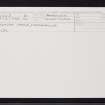Lynturk Castle, Castleknowe
Architectural Fragment (16th Century), Castle (Medieval), Farmhouse (19th Century)
Site Name Lynturk Castle, Castleknowe
Classification Architectural Fragment (16th Century), Castle (Medieval), Farmhouse (19th Century)
Alternative Name(s) Castleknowe Of Lynturk
Canmore ID 17591
Site Number NJ51SE 5
NGR NJ 59713 12333
NGR Description NJ 59713 12333 and NJ 5982 1224
Datum OSGB36 - NGR
Permalink http://canmore.org.uk/site/17591
- Council Aberdeenshire
- Parish Leochel-cushnie
- Former Region Grampian
- Former District Gordon
- Former County Aberdeenshire
Castleknowe of Lynturk, (?)1816. Gaunt two-storey, three-window house within the earthwork of much earlier (?15th century) Lynturk Castle, one of whose gunloops survives in the steading. The castle was held by the Strachans, one of whose sons, John, was renowned in mid-16th-century Scotland for 'every sort of villainy'.
Taken from "Aberdeenshire: Donside and Strathbogie - An Illustrated Architectural Guide", by Ian Shepherd, 2006. Published by the Rutland Press http://www.rias.org.uk
NJ51SE 5 59713 12333 and 5982 1224
(NJ 5972 1232) Castleknowe On Site of Lynturk Castle (NR)
OS 6" map, (1959)
Castle of Lenturk, built by John Strachan in 1514 (Laing 1828). Mentioned in 1612 by Monnipennie as one of the strongholds of Mar, and described in the Statistical Account (OSA) in 1792 as in ruins, having a deep broad ditch around (NSA 1845).
The ditch, still traceable as a circular hollow, encloses an area 125ft diameter, within which now stands a large farmhouse. Little remains of the castle but behind the farmhouse is a fragment of masonry showing a plastered wall recess, and preserved in the steading is part of a 16th century gunloop with circular orifice. Ancient stones have been re-used in the steading and the ruined Secession church dated 1762 hard by (Simpson 1949).
(New Statistical Account (NSA) 1845; W D Simpson 1949; A Laing 1828).
The site of Lynturk Castle is generally as described. The E arc of the ditch has disappeared completely. The N arc is only discernible as a very faint hollow. Elsewhere it has been preserved by the erection of a garden wall.
The small recess at NJ 5971 1234, as described by Simpson (1949), measures c.1.5 metres by c.1.0 metres and is covered by two stone flags. The gun loop is preserved in the steading at NJ 5983 1226.
The ruined Secession church is at NJ 5987 1223.
Surveyed at 1/2500.
Visited by OS (RL) 17 September 1968.
Field Visit (27 September 1994)
The remains of Lynturk Castle consist of a broad ditch around the SE side and parts of the NE and SW sides of a subrectangular area within which stands an unoccupied, though still roofed, farmhouse. The ditch has been landscaped, and a revetting wall now defines its outer edge, so that its original dimensions cannot be ascertained. There is no trace of the ditch to the N and W of the house. The two stone flags noted by the OS surveyor lie to the NW of the house. A gun-loop is set into the W wall of the steading (NJ51SE 58) to the SE, 5.4m from its SW corner at NJ 5982 1224.
(CRAIG94 82)
Visited by RCAHMS (SDB) 27 September 1994















